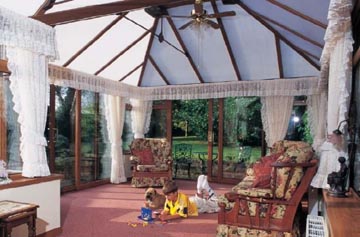David Bingham Managing Director of Conservatory Land has given an insight into the conservatory industry and the current trend he is seeing. With 20 years personal experience in the industry he has given some useful advice and tips for anyone looking to buy a conservatory.
Currently, one of the UK’s most popular and appealing home improvement projects for homeowners is adding conservatories to their homes. The choice is vast and if you are considering a sizable investment it is wise to start with the company itself. Choose a company that has satisfactorily supplied or installed conservatories for friends, family or someone else you know. The next step is to decide what type of conservatory you want, or more importantly, what type will best suit your property and keep within your budget.
Measure the space you have available and decide what size you would like and which style would look best. Choose a style and size that will provide you with a usable, furnishable living space whilst at the same time not looking out of place or out of proportion with your property. This step is the most important one so take your time as you will only get once chance to get it right. No one wants to end up with a conservatory that is too small to be of reasonable use or too large for the size and style of your home. David Bingham went on to say “I have heard so many times, customers saying that they wish they had purchased a larger conservatory so that there was more room to seat the whole family for dinner or for watching TV, so choose carefully, but don’t over do it, it needs to be just rightâ€.

Once you have decided on the size and style, be it an Edwardian, Victorian or a simple traditional lean-to conservatory, you need to decide on the actual design. There are three main designs to choose from, dwarf wall, full height glass to ground and full height bottom panels.
Then there are the doors. The most popular choice are French (double) doors but in some situations, sliding patio doors or bi fold doors and be more suitable for some conservatories depending of their location on your home and how you intend to use your conservatory. The company you choose will be able to give you further advice on design options and supply you with CAD drawings to help give you an idea of how the finished conservatory will look.
Colour is also very important. Modern PVCu profiles are available in many colours with the most common being white, mahogany, rosewood, golden (light) oak and more recently cream has been introduced. White PVCu is usually the cheapest option. It is a good idea to choose a colour that will best compliment the fabric of your property and your existing windows and doors.
The final step is to decide on glazing types, both for the frames and roof and you don’t necessarily need the exact same glazing type in the roof as the frames. Frame glazing for conservatories can take many different forms. The very basic frame glazing used in conservatories is clear toughened safety class, usually made up in double glazed sealed units.
However, you may want a higher insulating glass to help keep your conservatory warmer during the winter months such as Pilkington K Glass or a solar reflective glass to help keep it cooler in the summer such as Pilkington Activ Blue which is also self cleaning – or even a combination of both to help keep your conservatory more comfortable all year round. Your conservatory supplier will be able to give you advice and associated costs regarding this.
Then there’s the roof glazing which is very important. There are two basic materials, polycarbonate and glass.
You should decide how you would like your conservatory to look and consider your budget as glass roofs for conservatories are far more expensive and often require additional reinforcement of the frames and roof, further adding to the cost.
The main disadvantage with polycarbonate is the ‘drumming’ effect which can become very loud during heavy rain. Glass roofs can be a better option for conservatories as there is far less noise during rainfall.
David went onto say “I have tried to provide this advice with a view to helping anyone buying a conservatory, whether it is fully installed or a DIY conservatory to make sure that they get exactly what they want and need. When it comes to conservatories, especially DIY conservatories, getting it wrong can be a very expensive mistake and I like to think that ConservatoryLand is one company that can professionally advise on these issuesâ€.
Via EPR Network
More Construction press releases

